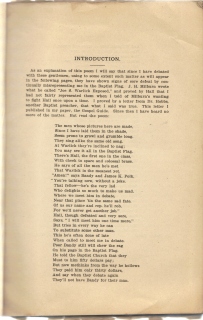At some point somewhere I talked about Restoration Movement sites in downtown Nashville, and how close they are. At the risk of trivializing the geography (Alexander Campbell slept here!) it is worth noting that one cannot move around too much downtown without walking across some site where something fairly significant happened.
Metro Archives posted this photo from 1965 to their Facebook page some years ago. It provided the perfect canvas to sketch out for my audience what I needed to say.
I must have been talking about the Hebrew Mission, because why else would that location be emphasized? The green highlights are on city streets in front of locations of interest. That is by design since Nashville natives know their city by street names, and that was one of my ‘hooks’ to draw in my audience. Also, since most of the landmarks are now obliterated, the streets are all that remain (and some of them have been renamed). This photo is also a good backdrop because 1) of the recognizable L&C Tower, and 2) it is so different from the skyline we now know (or have to endure). Point being it grabbed attention and let me sketch out the historical geography of some of the important places that figured prominently in my talk.
So, start at the upper right corner, and we’ll go counter-clockwise:
*Foster Street Church, the Northeast Nashville outpost of the emerging suburban growth of Churches of Christ in the 1880s. I think I mentioned this only to take advantage of the I-65 construction underway in this photo, and thereby make a point that the built environment has erased some of the important landmarks. Even many locals 20 years ago had never heard of Foster Street Church. Foster Street Church location is on the north margin of the on-ramp complex.
*Then go west over to Gay Street just north of the Capitol, site of the former Second Christian Church or Gay Street Christian Church, the major African-American congregation of Disciples and the first RM congregation in town to install an organ. That building was a casualty of the Capitol Hill redevelopment program, mid 20th c.
*Then almost due south to Vine Street (later 7th Avenue, North), and we see a parking lot on the east side of the street, next to the tall hotel. Site of the Vine Street Christian Church, built in 1889.
*Now a block or so south on 7th to the intersection at Broadway, to see the McQuiddy Printing Company building (still standing as the Barbershop Harmony Society headquarters). This is where Gospel Advocate was edited and published for a generation, mid 20th. c.
*Now, turn the corner and at the back side of the Masonic Temple on the corner, within a stone’s throw of McQuiddy, is a four story red brick storefront with apartments above. The Hebrew Mission occupied the ground floor of this building, ca. 1928-1932 or so.
*From there move northeast to Fifth Avenue, North, to see the Ryman Auditorium, and across the street from it the Central Church of Christ Girls Home (still standing in 1965, but would be razed in 1972). Across Commerce to the north is Central Church Administration building and auditorium.
*Now hop up and over and across the alley to the Life and Casualty Insurance building. The home office built before the tower is adjacent, red brick with a stone facade. Both face 4th Avenue North just shy of Church Street. Somewhere about where L&C complex sits was the Cherry Street Christian Church sat. This was the grand building built for Jesse Babcock Ferguson in the late 1840s-early 1850s. The old Church Street Christian Church sat about where the Public Library downtown branch sits, and it is not marked on this photo.
Time was you could drop me on just about any corner in Nashville, Tennessee, and not only could I find my way home, I could talk about RM sites along the way. Given how much the built environment has changed in ten years, I don’t know if I would recognize it much at all.















